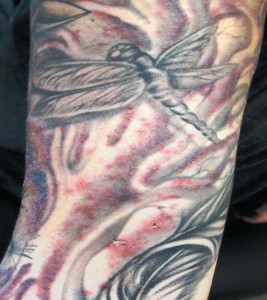
Courtesy of New England Journal of Medicine
Although allergic reactions to tattoo ink and redness during the healing process after a tattoo are not completely unusual, a topical bacterial infection in the tattooed area is cause for concern — but, to the naked eye, the differences are slight. Last October, the UR Medical Center (URMC) began receiving what ultimately amounted to 19 cases of patients with tattoo-related bacterial skin infections that were, at first, passed off as allergic reactions; a study was recently published in the New England Journal of Medicine concerning the matter this month.
“It was initially brushed off as an allergic reaction, but then did not improve so biopsies were performed, confirming the diagnosis,” Mary Gail Mercurio, one of the study’s authors and a dermatologist at URMC, said.
Mercurio personally saw 18 of the 19 cases of infection, while Robert Betts, infectious disease expert, treated many of them. Betts was also responsible for confirming that the infection was related to the tattooed area of skin.
The bacteria responsible for these infections, Mycobacterium chelonae, was living in tap water that was used to dilute a pre-mixed grey ink manufactured in Arizona. The bacteria in the ink, which was shipped to and used in an unknowing tattoo parlor in Rochester, found easy entrance into the broken skin that is a byproduct of receiving a tattoo.
According to Betts, M. Chelonae grows best at around 86 degrees Fahrenheit, which is just slightly lower than the average body temperature. But skin, which is cooler than internal body areas, made for an ideal environment for the bacteria to propagate.
Similar infections have occurred “sporadically” elsewhere, Mercurio said, but this is the largest documented occurrence of a single-source tattoo-related bacteria infection.
The concentrated population of affected patients and clear relation to a specific source caused the U.S. Centers for Disease Control and Prevention (CDC) to release a nationwide alert about the ink after investigating the matter; the CDC also highlighted this investigation in its Morbidity and Mortality Weekly Report. After becoming aware of the situation, the manufacturer willingly recalled any possibly contaminated ink to avoid further public health concerns.
Fortunately, Betts was able to treat the 16 patients he evaluated with azithromycin and doxycycline, both of which are standard oral antibiotics. Although the patients improved at varying speeds due to the differences in the severity of their infections, all patients did improve.
M. Chelonae is not only a concern in this specific situation, but in any situation involving broken skin where bacteria can easily enter. It is also an unsafe bacteria to have in drinking water.
The Pew Research Center reports that 36 percent of Americans aged 18 — 25 have at least one tattoo, but despite this large and persistent demographic, Mercurio offers a word of caution to college students who intend to get a tattoo.
“Unfortunately, there is no regulatory body overseeing tattoo parlors or their suppliers,” she said. “Call me old-fashioned, but given the complicated risk and permanence of procedure, I do not recommend tattoo. But for those who do get them, it is prudent to have any reaction evaluated sooner rather than later to initiate appropriate treatment.”
Sklar is a member of the class of 2014.

